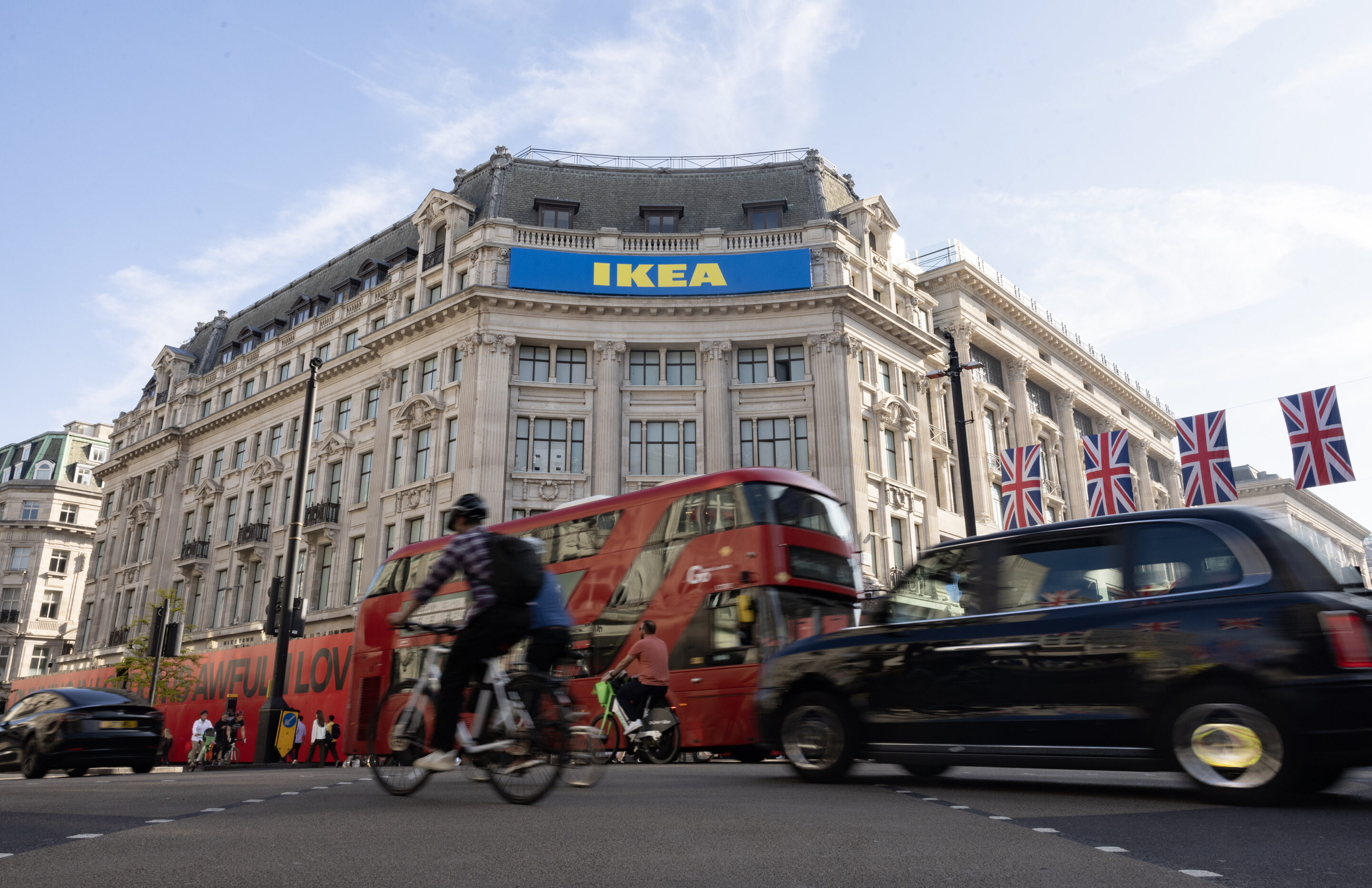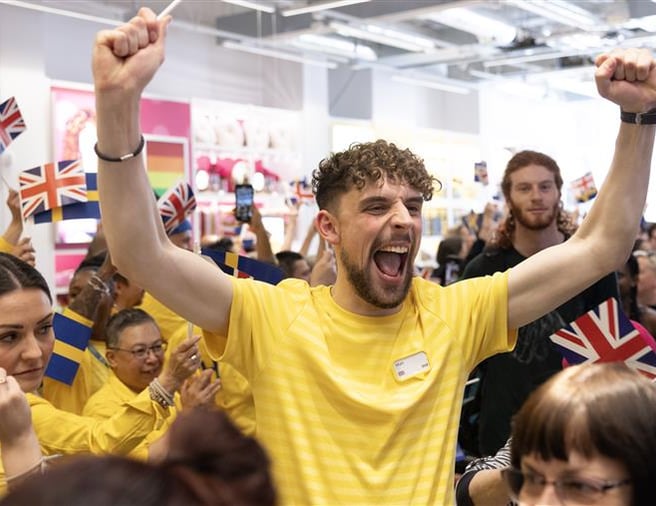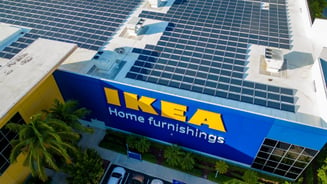At just 27 years old, Matt Gould is the London City Market Manager for one of IKEA’s most talked-about new stores – the IKEA Oxford Street store in London. In episode 2 of this new series of recorded discussions, Matt joins us to share what it’s really been like in the first weeks since opening, the challenges and moments of pride along the way, and his journey from working on the checkout at 16 to becoming a market manager.
We talk about what makes the Oxford Street store unique, why staying close to people is at the heart of leadership, and how Matt finds moments to switch off in a busy role.

The new IKEA City store on London’s Oxford Street. Picture date: Thursday May 1, 2025. Photo credit should read: Matt Alexander/PA Media Assignments. Photo is available for download under media assets below.

Matt Gould, far left at the opening of IKEA Oxford street on 1st May.
Sir Sadiq Khan, Mayor of London officially opens the new IKEA City store on London’s Oxford Street. Picture date: Thursday May 1, 2025. Photo credit should read: Matt Alexander/PA Media Assignments. Photo is available for download under media assets below.
Full transcript available below:
Thanks for joining us today, I’m here with Matt Gould from IKEA UK. Now Matt is the London City Market Manager at our new IKEA Oxford Street store, which opened only a few weeks ago. Welcome, Matt.
I want to first start by saying congratulations on the opening. It was, I think, global news around the world. So, if I just start there, what’s the last few weeks been like for you personally?
Well, thank you. Thank you for having me as well. But yes, it’s been – I would describe maybe as a roller coaster. It’s probably the best way to put it. I think with, as you said, so much focus and so much energy from so many people being part of the opening, it was really quite an incredible opening day. I mean, the opening day was something that I’d never experienced before, and it was fantastic. But I think since then, of course, there’s been a lot of focus still on the store with customers loving it. And I think that’s been something, a big positive for us: how many people are willing to come to Oxford Street. They’ve travelled quite a way actually.
Have you been surprised by the reaction, Matt, or were you expecting it? And have you been surprised by the customers’ reaction as well?
I think, well, the amount of customers that we’re actually getting through the doors has been a surprise. Of course, we expected Oxford Street to be busy with the amount of visitors, but it really has been spectacularly busy. But actually, the customers are so excited when they come in – there’s a lot of energy. And I think the biggest surprise is how much space we have in the store and how much we’ve managed to fit in. Customers don’t get the sense that it’s a small store. They feel it’s quite a normal-sized store and a lot easier to navigate. That was a big challenge for us: how to ensure the store was easy to get around. And we know that in Oxford Street, people don’t have a lot of time – it’s a busy location. So, it was important that we made navigating the store a good experience. The feedback has been super positive with customers enjoying it and seeing IKEA in Oxford Street.
How does the store differ from the bigger store, Matt? And does that change the way that you have to lead your teams in any particular way?
I think of course, we’re always IKEA. No matter where we show up, there are always elements that are the same. But in Oxford Street, we’ve done a lot more work with local people, with Londoners. A big learning we took from Hammersmith was that while we open stores with grand room sets and high inspiration, people living in and around Oxford Street don’t have the space for huge living rooms and kitchens. They live in smaller locations.
What’s super unique about Oxford Street – and the only place we’ve done this – is we collaborated with Londoners. They’ve actually designed all the room sets on the ground floor and the vignettes in what we’re calling culture clusters. Every single one was designed by people who live and work in London. So, when customers visit, they can connect more easily with the solutions and actually see their own homes represented in the store. That’s something that big units don’t always land – real local PMA and connection with the customer. So that’s super cool. I like it.
Now Matt, for people who may be watching this and not just listening, they’ll see something in you immediately, which is the fact that you’re only – if you don’t mind me saying – 27 years old. And you’re now market manager in London for Oxford Street and IKEA Hammersmith. Can you tell us a little bit about your journey? How have you got here?
Well, I started 11 years ago, so if you’d asked me then whether this is where I’d be today, I’d have said no way. I started at 16 years old on the checkouts in Warrington, which was the first store in the UK. At the time, I had no plan to go to university. I was still in college when I joined IKEA with no real plan for what I wanted to do. But I knew I wanted to get into work. I’m quite active and hands-on, and the working environment was where I wanted to be.
That was the start – from part-time to full-time. At 18, I took my first leadership role as a team leader in customer services. That was quite grounding, with customers often saying, “Can I speak to a real manager?” They thought I was too young. But that always stayed with me. For me, age is irrelevant. Age brings experience, yes, but it shouldn’t stop you from progressing.
When I joined the customer services team, I knew I wanted to explore IKEA. We have many areas: sales, logistics, etc. I moved into logistics – not as a clear path, just because it was new and exciting. Then I moved into sales a couple of years later, and that’s where I get the most energy. Having touch points in logistics and customer service helped me understand the business more deeply. But what never changed was how I interacted with people and led teams. I always show up the same, no matter the role.
Even today, I hope people see I haven’t changed from who I was three or four years ago. What’s helped me is working with people and using their knowledge. I don’t know everything – I say this a lot to my team. IKEA is complex. But we have people who specialize. My job now is to enable them to excel and create an environment where people feel ownership and don’t fear their day-to-day. When they can be themselves, test ideas, and grow – that’s when you get a strong team that can deliver and enjoy the process.
From the very beginning, I’ve been passionate about the idea that leadership isn’t about age – it’s about how you build a team. And I’ve always tried to be natural and not change myself to fit a mould. Because if you change yourself to please others, you can’t sustain that. You have to be true to yourself.
Is there anyone who’s inspired you on your journey? And do you think if you’d worked at another company, you would’ve become a leader at 27? Or is IKEA unique in how it approaches leadership – leaning on culture and values?
For sure, IKEA is a unique company to work for. It gives opportunities to people who might not look like “the next leader” on paper. It doesn’t follow a rigid pathway. Decisions are made based on values.
The person who inspired me most was my store manager in Warrington. He was clear that you’re never going to know the whole of IKEA – it’s a full business with specialists. But you can enjoy what you do and show up in a way that’s authentic to you. In other businesses, there’s often a rigid ladder – you must do this role, then this role, to eventually get “there.” IKEA isn’t like that. My journey wasn’t linear, but IKEA allows that. Whether you start from the beginning or come in later, there are opportunities either way. That’s not common in other companies.
Just going back to the Oxford Street opening, what do you think you’re most proud of in the last month or so?
Oxford Street was delayed, and that was really tough. We’d closed our Tottenham unit and were working hard to bring as many coworkers from Tottenham into Oxford Street. We retained nearly 100 coworkers, and our ambition was to open in 2024 – but we didn’t.
So on opening day, seeing those coworkers who stuck with us – it was very special. The opening was done by a team of former Tottenham coworkers. The girl who unzipped the store was the first Tottenham coworker we brought to Oxford Street. She had been with us 2.5 years and had never worked in the store yet. That was an incredible moment.
I’m also proud that we opened in Oxford Street at all – it’s such a fantastic location. We were joined by representatives from all over the country. Our CEO, retail manager, everyone was there, celebrating together. It felt like a family, and it didn’t matter where in the business you worked – everyone was on the shop floor, serving customers. It was a true team effort and an incredibly proud moment.
A current question – when the store opened, IKEA UK CEO supported pedestrianisation of Oxford Street. If that were to happen, hypothetically, do you think it would benefit the store?
Oxford Street has had a tough time over the last four or five years. COVID didn’t help, and afterward we saw businesses moving in that weren’t the right fit. But now those are gone, and new big brands are arriving. The goal is to revitalise the high street – to bring people back.
Pedestrianisation could definitely help. Parts of Oxford Street aren’t currently ready for big footfall. But with wider pavements and a better shopping experience, it wouldn’t just help IKEA – it would help all the brands. Especially during peak times like Christmas, we want people to enjoy their time in Oxford Street, whether shopping or dining. Pedestrianisation would make that easier and better for everyone.
And just finally, Matt – are you able to switch off on your days off? Do you manage to disconnect from work, or is that tough with your responsibilities?
No, it’s tough. I’d be lying if I said otherwise. With the store being new, you want to be there, to make sure things are OK. But it’s important to switch off. I got advice from my old store manager: twice a year, I book an Airbnb somewhere quiet. I don’t take my phone. I go to a pub, have a beer, walk, sit in silence. No calls. Just time to reset.
I do it after Christmas and after the summer peak. It helps a lot. Retail is intense, whether you’re on the floor or not. You need to take a day to stop. Whether that’s totally switching off or just going shopping – whatever it is, take that breath. I’ve learned the business runs even when I’m not there. That took time to accept. Now I structure my year to include those resets, so I can keep going in the right headspace.
Maybe that’s what makes you a leader at 27. I’m sure a lot of people listening will take inspiration from your approach. Really interesting stuff. Matt, thank you so much for taking the time today. Really appreciate it.
No, thank you, and thank you for allowing me to share. It’s been a fun journey. Still plenty to do for me – and for Oxford Street and Hammersmith. But I really enjoyed this today. Thank you very much.
Thanks a lot. Until next time – thanks for listening.
Media enquiries
For further information, journalists and media professionals can contact us at [email protected] or by calling +46 70 993 6376.









